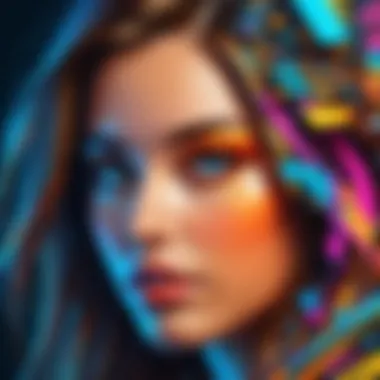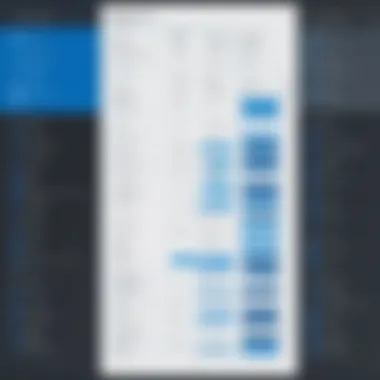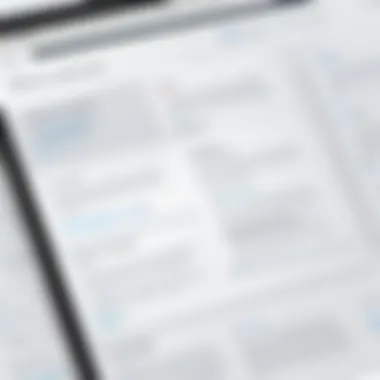Explore Free Drawing Software for Windows


Intro
The realm of digital drawing has evolved significantly, offering a variety of software options to both novice and experienced artists. With the rise of free platforms, Windows users particularly have access to numerous drawing tools that cater to diverse artistic needs. Understanding these tools can significantly impact the creative process and the quality of artistic outputs.
In this article, we delve into various free drawing software available for Windows. We will present key features, usability, and performance insights from users and experts. This analysis aims to help users, whether they are tech enthusiasts or professionals, make informed decisions on the drawing tools that best suit their artistic aspirations or professional requirements.
As we unfold each software's strengths and weaknesses, we will include practical applications and real user testimonials to provide a well-rounded perspective. The landscape of digital drawing software is vast, and with careful exploration, we can find the right fit for every artist's unique style and workflow.
Prologue to Free Drawing Software
The realm of free drawing software is essential for artists and designers seeking effective tools without financial burden. These programs help foster creativity and enable the production of high-quality artwork in a digital format. By focusing on free options, we not only present practical solutions but also encourage accessibility in art and design.
Defining Free Drawing Software
Free drawing software refers to computer programs that allow users to create and manipulate digital artwork without any cost. These tools range widely in features and complexity. Some offer advanced functionalities similar to commercial applications, while others cater to basic drawing needs. Key aspects include:
- Accessibility: Many users may hesitate to invest in expensive software, especially beginners. Free drawing software provides a platform that anyone can explore.
- Variety: The diversity of options ensures that there is likely a tool tailored to specific artistic styles or preferences.
- Trial and Exploration: Users can experiment with different software without the pressure of financial commitment, which is vital for developing skills and style.
Importance in Digital Art and Design
The significance of free drawing software cannot be overstated. In the digital age, having access to powerful tools often determines the quality and impact of artistic projects. Here are some reasons that highlight this importance:
- Skill Development: For aspiring artists, free drawing software provides an opportunity to practice and hone drawing skills. It allows beginners to learn the tools and techniques required in digital art.
- Community Engagement: Many platforms foster communities where users can share their work, seek feedback, and collaborate on projects. This engagement can lead to greater exposure and learning.
- Professional Use: Some free tools, like Krita and GIMP, are robust enough for professional use, offering features that competitors charge for. This opens doors for independent artists and small businesses.
- Innovation and Experimentation: Free tools encourage experimenting with styles and techniques without the risk of wasting resources. This ability to innovate is crucial in the constantly evolving field of digital art.
"Access to drawing software is an equalizer in artistic expression, removing financial barriers and enriching digital creativity."
Through this lens, exploring free drawing software reveals how these tools shape the landscape of digital art and design. Not only do they democratize access to artistic resources, but they also nurture the next generation of creators.
Overview of Windows as a Platform for Artists
Windows has long been a favored platform for artists, designers, and illustrators. This popularity originates from its versatility and extensive array of available software options. As a flexible operating system, Windows supports a variety of drawing applications catering to different artistic needs and preferences.
For many artists, the ability to choose from numerous free drawing tools is a significant benefit. Unlike some other platforms, Windows provides a broad selection, ensuring that both amateur and professional artists can find a tool that meets their specific requirements. This access to various applications supports creative experimentation, encouraging users to explore styles and techniques.
Additionally, Windows ensures compatibility with a multitude of hardware, from graphic tablets to touchscreen laptops. This compatibility enhances usability and improves the overall experience for artists, allowing seamless integration of software and hardware solutions. Many drawing tools become so much more effective when paired with the right devices, leading to higher-quality artwork.
With its continual updates and development, Windows keeps pace with technological advancements, ensuring that artists have access to modern features and tools. This allows artists to not only create but to explore innovative methods of expression.
Popularity Among Artists
The popularity of Windows among artists can be attributed to several factors. First, the operating system's widespread use in both personal and professional settings means that many artists are familiar with its interface and capabilities. This familiarity reduces the learning curve when new drawing software is introduced.
Moreover, many influential design tools have a Windows version, making it easier for artists to adopt software they have heard of or seen in practice. Some drawing programs, like Krita, GIMP, or Inkscape, cater specifically to digital artists. This level of accessibility enhances user engagement and satisfaction.
Another reason for Windows’s popularity is the active community that surrounds it. Forums such as Reddit or dedicated Facebook groups allow users to share experiences, tutorials, and feedback about their drawing software. This community aspect supports users in troubleshooting issues and improving their skills.


Considerations for Software Compatibility
When choosing drawing software for Windows, compatibility is an essential aspect to consider. Not all software work harmoniously with every version of Windows, leading to potential performance issues if the wrong tool is selected. Therefore, verifying software requirements before installation is critical.
Additionally, artists often utilize multiple types of software in their workflow. Ensuring that different programs can effectively communicate and share files is important. For instance, if an artist works in both Adobe Photoshop and GIMP, they must ensure that file formats like PSD can be effectively opened in these programs.
File format compatibility also extends to hardware. Graphic tablets and styluses must have the appropriate drivers and software support to work efficiently with chosen drawing programs. This aspect is vital as it influences the overall drawing experience, impacting productivity and ease of use.
In summary, compatibility considerations play a significant role in the success of an artist's workflow on Windows. By being mindful of software and hardware compatibility, artists can optimize their creative processes and avoid common frustrations.
Key Features to Look for in Drawing Software
Selecting the appropriate drawing software is essential for artists and designers alike. Various features contribute greatly to the usability and performance of these applications. A good understanding of these key features can help users make informed choices and enhance their creative workflow.
User Interface and Experience
The user interface (UI) greatly impacts how efficiently an artist can create. A clean and intuitive UI allows users to navigate through tools and options without confusion. Many applications present a cluttered interface, which can impede creativity and slow down the workflow. Thus, look for a software that offers customizable layouts. Users should be able to prioritize tools that they use most frequently.
Moreover, responsiveness of the interface to touch inputs or stylus can be critical for artists working on tablets or touch-enabled devices. Software like Krita or Inkscape are often praised for their user-friendly interfaces that foster an enjoyable drawing experience. User experience (UX) encompasses not merely the aesthetic aspect but also how smoothly the software performs tasks, including loading times and responsiveness to commands.
Tool Variety and Customization
The versatility of tools within the software is another important consideration. A rich variety of brushes, pencils, and effects enable artists to experiment and express their creativity fully. It is advantageous for software to provide customization options for these tools. For instance, advanced users might desire the ability to adjust brush settings, including opacity, size, and blending modes. Furthermore, having the option to create custom brushes, as seen in programs like MediBang Paint, allows artists to expand their toolkit significantly.
Besides traditional tools, consider whether the software includes features like layers, masks, and vector capabilities. These elements are essential for professionals working on complex projects. Customizing shortcuts and palettes can also enhance productivity. A software that accommodates these preferences grants artists more control over their projects and overall artistic process.
File Format Compatibility
File format compatibility is paramount when dealing with drawing software. Artists frequently collaborate with others, often requiring the ability to import and export a variety of formats. Common formats include JPEG, PNG, and TIFF, but support for PSD is essential for compatibility with Adobe Photoshop.
The ability to save in multiple formats provides flexibility. Additionally, some software like GIMP allows exporting to specialized formats, which may be necessary for specific industries. Always verify that the chosen software supports the preferred formats for the user's projects.
"An artist’s toolkit is not complete if the software lacks flexibility in file handling."
Comparison of Top Free Drawing Software for Windows
Evaluating various drawing software is vital in understanding their unique offerings, strengths, and limitations. Free drawing software often provides a range of capabilities that can cater to different artistic needs. Comparing these options allows users to identify which tools align best with their personal or professional projects. This section emphasizes factors such as user experience, functionality, and specific features that may influence a decision.
Software One: Features and User Feedback
Software One presents a user-friendly interface that focuses on simplicity and accessibility. Users appreciate the intuitive layout, which encourages creativity without overwhelming them with choices. The software provides basic drawing tools, a variety of brushes, and enables layer management, all essential for both beginners and advanced artists.
Feedback from users highlights its reliable performance in handling simple sketches to more complex designs. However, some users pointed out limitations with advanced features like text tools or vector capabilities.
Software Two: Features and User Feedback


Software Two stands out due to its robust set of features ideal for graphic design. It offers numerous customizable brushes and an extensive color palette, appealing to artists who prioritize detail in their work. Users frequently comment on the speed and responsiveness of the application, making it suitable for time-sensitive projects.
Nevertheless, some reviews indicate a steep learning curve. New users find it challenging to navigate the multitude of features. This may deter those who seek straightforward software without extensive training.
Software Three: Features and User Feedback
With Software Three, expectations align more closely with digital painting. This software shines in emulating traditional painting techniques. It includes specialized tools like blending and texture brushes, which many users find beneficial in creating realistic effects. Users often commend its performance with high-resolution canvases, showcasing its capability to handle complex projects.
Despite its strengths, feedback reveals occasional stability issues, particularly on older systems. Some users have experienced crashes during intensive sessions.
Software Four: Features and User Feedback
Software Four is designed for simplicity. It focuses on essential tools catering to those who want quick and effective drawing solutions. Many users appreciate its straightforward layout for sketching ideas rapidly. The software integrates easily with other Windows applications, enhancing workflow efficiency.
However, this simplicity comes at a cost. Users looking for advanced features may find this software limiting. Feedback often regards it as best suited for users focused primarily on basic drawing tasks.
Software Five: Features and User Feedback
Finally, Software Five is praised for its versatility. It combines features for both drawing and photo editing. This dual functionality makes it appealing to users who wish to seamlessly integrate their artistic and editing workflows. Users have highlighted the flexibility in tool customization, allowing personal adjustments.
On the downside, some users have reported high resource demands, requiring powerful hardware for optimal performance. Feedback frequently points out that less powerful machines struggle to run the software smoothly.
"Finding the right drawing software is about balance. Consider what features matter most for your work style and needs."
Users must weigh these factors carefully to make informed choices that match their creative aspirations.
Usability Insights from Real Users
Understanding usability insights from real users is crucial when evaluating free drawing software for Windows. This section aims to distill feedback from actual users, emphasizing their experiences and opinions on various software options. Real user insights provide a practical perspective that goes beyond marketing claims and technical specifications. By focusing on user experiences, we highlight how these tools perform in real-world scenarios, thus aiding prospective users in making informed decisions.
User Testimonials
User testimonials serve as valuable first-hand accounts that can shed light on the strengths and weaknesses of specific software. These insights often highlight aspects like ease of use, functionality, and user support. For instance, many users consistently praise Krita for its array of advanced features while noting its intuitive interface. Here are some key points from user testimonials:
- Ease of Learning: New users often state that software such as Medibang Paint offers a smoother learning curve compared to others. This aspect is crucial for beginners who want to dive into drawing without overwhelming complexity.
- Feature Robustness: Users have remarked about Inkscape's impressive vector capabilities. These features allow for precise control over designs, making it a preferred option among those focusing on professional design work.
- Platform Stability: A significant number of testimonials mention that programs like GIMP run smoothly on various Windows versions. Users appreciate the consistent performance without frequent crashes, which is essential for maintaining workflow.
"The transition from learning to creating art was seamless with Medibang Paint. It just clicks!"
These testimonials highlight real use cases, providing insights into which tools might best suit their specific needs.
Common Challenges Faced
Even with comprehensive software, users encounter challenges. Understanding these common struggles helps paint a fuller picture of each tool's usability. Here are some frequently noted issues:
- System Requirements: Some software, like Blender, requires powerful hardware. Users with older machines often face performance lags, limiting their ability to use the tool effectively.
- Learning Complex Features: While advanced features are valued, they can also pose challenges. Software such as GIMP has powerful tools but requires significant time to master, discouraging some users.
- Limited Support Community: New users sometimes report a lack of clear documentation or community support, particularly with lesser-known software. This scenario makes it difficult for them to resolve issues quickly.


Addressing these challenges is vital for users when selecting software that aligns with their capabilities and expectations. Recognizing potential pitfalls allows for a more effective decision-making process and enhances user experience.
Tips for Choosing the Right Software
Selecting the right free drawing software for Windows is critical for artists, designers, and even casual users. The abundance of options can often lead to confusion. Understanding your specific needs may better position you to find the tool that enhances your creative process effectively.
Assessing Your Drawing Needs
Before deciding on software, it is essential to assess your drawing needs. What type of art do you want to create? Are you focused on vector graphics, or do you prefer raster images? Different software caters to various styles and techniques.
Consider the following aspects while evaluating your needs:
- Art Style: Determine if you are into sketches, detailed illustrations, or digital painting. This affects the type of tools you require.
- Experience Level: A beginner may benefit from software with an intuitive interface and tutorials, while a professional might seek advanced features and customization options.
- Device Compatibility: Ensure that the software runs smoothly on your device. High-performance tools may require more robust hardware.
- Community and Resources: Active user communities can offer support, tutorials, and plugins that could be invaluable.
Identifying your specific needs allows for a clearer focus on essential features, ensuring that you do not waste time on software that does not align with your artistic goals.
Trying Before You Commit
Once you narrow down your choices, "trying before you commit" becomes crucial. Free trials and demo versions provide a hands-on experience and can reveal much about usability.
Consider the following benefits of testing software:
- Usability Testing: You can gauge whether the user interface meets your expectations. Is it easy to navigate? Can you locate the tools you need without frustration?
- Feature Exploration: Trying out tools tells you if they perform effectively for your style. For example, a brush engine might suit some artists but not others.
- Performance Evaluation: Observe how the software handles tasks under typical load conditions. Does it crash, or is it responsive?
- Customization and Extensions: Determine if the software allows for personal customization or additional brushes and plugins, as these can significantly enhance your work.
A practical approach to exploring software options can lead you to a better-informed decision. As is often said in design circles, the best tool is the one that fits seamlessly into your workflow.
By assessing your needs and testing software, you ensure that your choice aligns with your artistic vision and technical requirements.
End and Recommendations
In this article, we have delved into the world of free drawing software available for Windows. The insights gathered through analyses and user testimonials underline the significance of selecting the right tools for digital art creation. The recommendations shared in this section aim to summarize the findings and provide actionable guidance for potential users.
Choosing appropriate drawing software is paramount for both novice and seasoned artists. The right program not only enhances creativity but also streamlines the workflow. Key elements to consider include the software's user interface, feature set, and compatibility with other tools. Accessibility plays a major role too. A user-friendly application can significantly affect productivity, especially for those starting in the digital art sphere.
When making a selection, it is beneficial to weigh the strengths and weaknesses of various options. Some software may excel in certain areas like brush variety, while others might focus on ease of use or advanced functionalities. Therefore, a thorough evaluation of these aspects according to personal needs and artistic goals is essential. Investing time into testing multiple applications before committing is a wise strategy that minimizes the chances of regret later.
Furthermore, gathering feedback from communities, such as forums on Reddit or discussions on Facebook, offers additional insights into how others approach similar decisions. This peer perspective can be invaluable when navigating the myriad of choices available.
"The right tools can transform your creative journey, making it smoother and more enjoyable."
Final Thoughts on Free Drawing Software
As we've explored, free drawing software for Windows is not just a cost-saving measure; it represents a vast landscape of potential for growth and creativity. The software options presented have unique attributes catering to diverse artistic needs. For instance, some artists may prefer software like Krita for its extensive brush engines, while others might lean towards Inkscape for vector graphics.
Understanding one's preferences and requirements can guide the process of finding the ideal software. Free drawing software can empower artists to experiment without fear of financial burdens. Ultimately, the aim should be to enhance one's artistic abilities and foster a sense of creativity, making the selection of compatible software an integral part of the artistic process.
Encouragement for Continued Exploration
The digital art landscape is ever-evolving, with new tools emerging regularly. Artists must remain open to experimentation. This exploration not only includes trying out different software but also engaging with tutorials, online courses, and artist communities. Connecting with others helps broaden perspectives on the tools available.
Encouraged by the findings in this article, artists should venture beyond familiar limits. There are numerous free drawing applications to discover, each offering distinct functionalities. By continuously exploring and adapting, artists can refine their skills and enhance their artistic practice.
In summary, while it is important to choose the right free drawing software, the journey of exploration should not cease after the initial choice. Embrace new challenges, as each venture will contribute to personal growth and artistic evolution.















